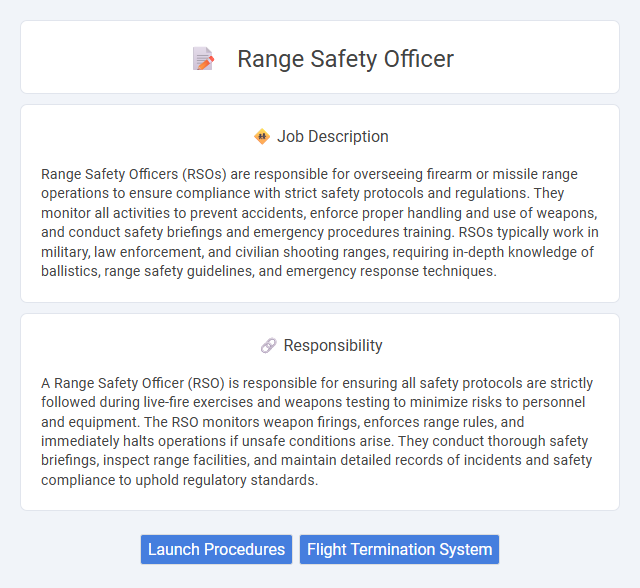
Range Safety Officers (RSOs) are responsible for overseeing firearm or missile range operations to ensure compliance with strict safety protocols and regulations. They monitor all activities to prevent accidents, enforce proper handling and use of weapons, and conduct safety briefings and emergency procedures training. RSOs typically work in military, law enforcement, and civilian shooting ranges, requiring in-depth knowledge of ballistics, range safety guidelines, and emergency response techniques.
Individuals with strong attention to detail and the ability to remain calm under pressure are likely suitable for a Range Safety Officer role, as these conditions are critical for ensuring safe operations. Those who possess good communication skills and a thorough understanding of safety protocols may find themselves more capable of effectively managing risks. Candidates lacking these attributes might struggle to perform consistently in this high-responsibility position.
Qualification
A Range Safety Officer (RSO) must possess extensive knowledge of firearms safety protocols, federal and local regulations, and emergency response procedures. Qualifications often include certification from recognized safety organizations such as the NRA or military experience, along with strong communication skills to enforce rules and conduct safety briefings effectively. Physical fitness and the ability to remain vigilant in high-pressure environments are essential to maintain a secure shooting range.
Responsibility
A Range Safety Officer (RSO) is responsible for ensuring all safety protocols are strictly followed during live-fire exercises and weapons testing to minimize risks to personnel and equipment. The RSO monitors weapon firings, enforces range rules, and immediately halts operations if unsafe conditions arise. They conduct thorough safety briefings, inspect range facilities, and maintain detailed records of incidents and safety compliance to uphold regulatory standards.
Benefit
A Range Safety Officer likely ensures strict adherence to safety protocols, minimizing the risk of accidents and enhancing overall operational security. This role probably provides opportunities for professional growth and skill development in safety management and emergency response. Job benefits may include competitive pay, comprehensive training, and a critical position within military, law enforcement, or private sector environments.
Challenge
The Range Safety Officer role likely involves managing complex safety protocols to mitigate risks during live-fire exercises, which can be highly challenging. Coordinating multiple personnel and ensuring strict adherence to safety regulations may require quick decision-making and strong attention to detail under pressure. These challenges demand a proactive mindset to anticipate potential hazards and maintain a secure training environment.
Career Advancement
Range Safety Officers oversee operational safety protocols at shooting ranges, ensuring compliance with strict regulatory standards and mitigating risks. Career advancement opportunities include progressing to senior range safety supervisor roles, training coordinator positions, or expanding into military and law enforcement safety management. Specialized certifications and extensive field experience significantly enhance promotion prospects within this niche safety profession.
Key Terms
Launch Procedures
Range Safety Officers oversee strict launch procedures to ensure the safety of personnel and equipment during missile or rocket launches. They coordinate pre-launch checks, verify range clearances, and activate safety protocols such as abort sequences and emergency shutdowns. Their critical role minimizes risk by enforcing compliance with established safety standards throughout the entire launch operation.
Flight Termination System
A Range Safety Officer (RSO) is responsible for overseeing the safe operation of launch vehicles by managing and monitoring the Flight Termination System (FTS), which is crucial for preventing hazards during rocket launches. The FTS is designed to destruct a malfunctioning vehicle mid-flight to protect public safety and property, requiring the RSO to ensure its readiness, perform real-time monitoring, and execute termination commands if necessary. Effective coordination with launch control, adherence to strict protocols, and comprehensive knowledge of telemetry and tracking systems are critical for an RSO to successfully manage the FTS and maintain range safety.
 kuljobs.com
kuljobs.com